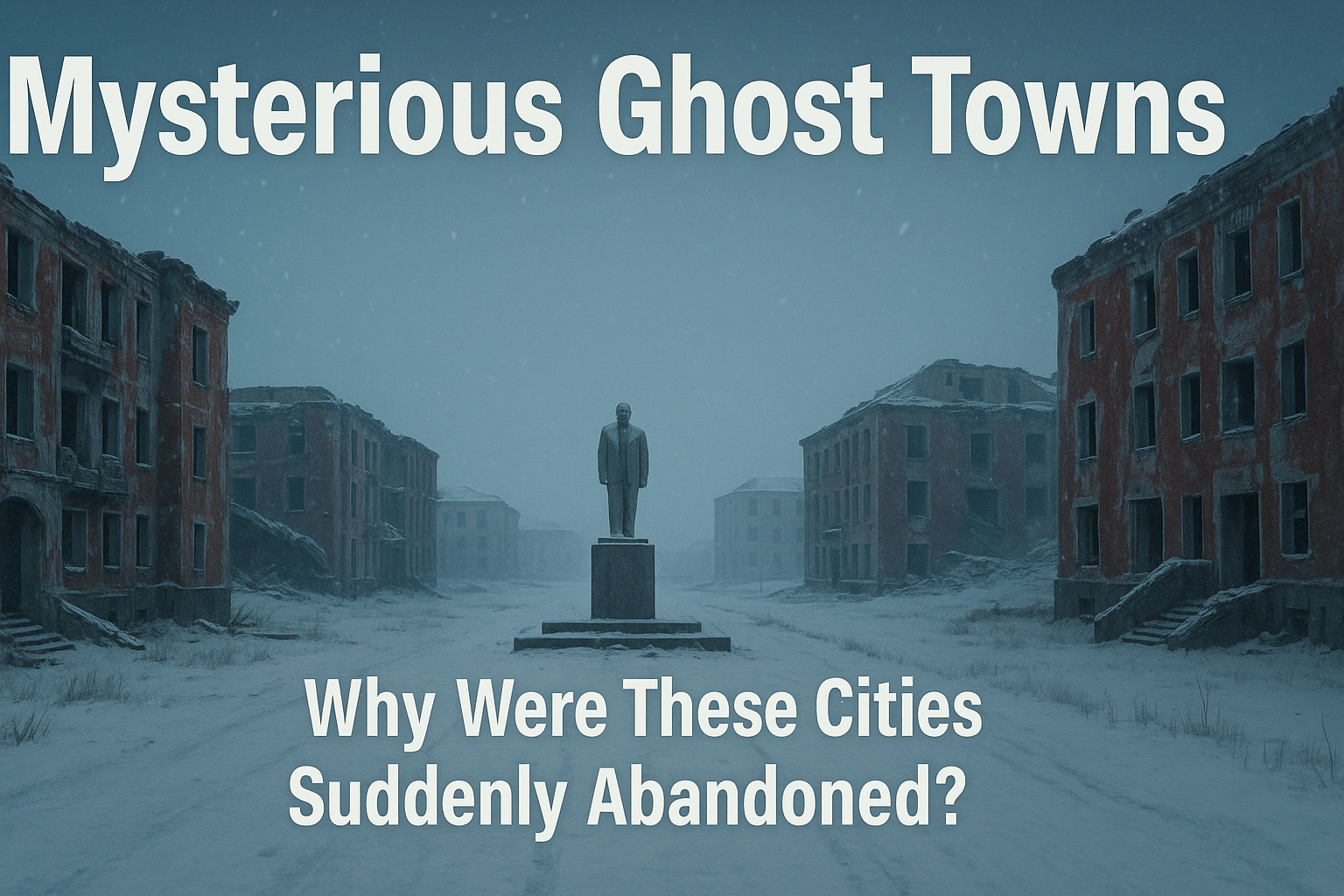
The world is dotted with places where time seems to have stopped. Towns and cities, once vibrant hubs of human activity, now stand silent, their streets empty, their buildings decaying, and their stories whispering on the wind. While some are abandoned for clear economic reasons or natural decline, others were left behind under circumstances shrouded in mystery, panic, or unresolved questions.
These ghost towns capture our imagination, prompting us to wonder what happened, how quickly life vanished, and what secrets the silent structures hold. From places emptied by disaster to those simply left behind with puzzling suddenness, each offers a glimpse into the fragility of human settlement and the power of unpredictable events.
Let’s explore 10 towns that were abandoned under circumstances that remain mysterious, eerie, or compellingly strange.
- 1. Pripyat, Ukraine – The Nuclear Ghost City
- 2. Centralia, Pennsylvania, USA – Burning Beneath
- 3. Craco, Italy – The Crumbling Hilltop Town
- 4. Bodie, California, USA – A Gold Rush Freeze Frame
- 5. Kolmanskop, Namibia – Swallowed by the Desert
- 6. Hashima Island (Gunkanjima), Japan – The Battleship Island’s Silence
- 7. Pyramiden, Svalbard – The Soviet Arctic Outpost
- 8. Kayaköy, Turkey – The Ghost Village of the Aegean
- 9. Famagusta (Varosha),Cyprus – The Fenced-Off Resort
- 10. Agdam, Azerbaijan – The Caucasian Hiroshima
- Conclusion
1. Pripyat, Ukraine – The Nuclear Ghost City
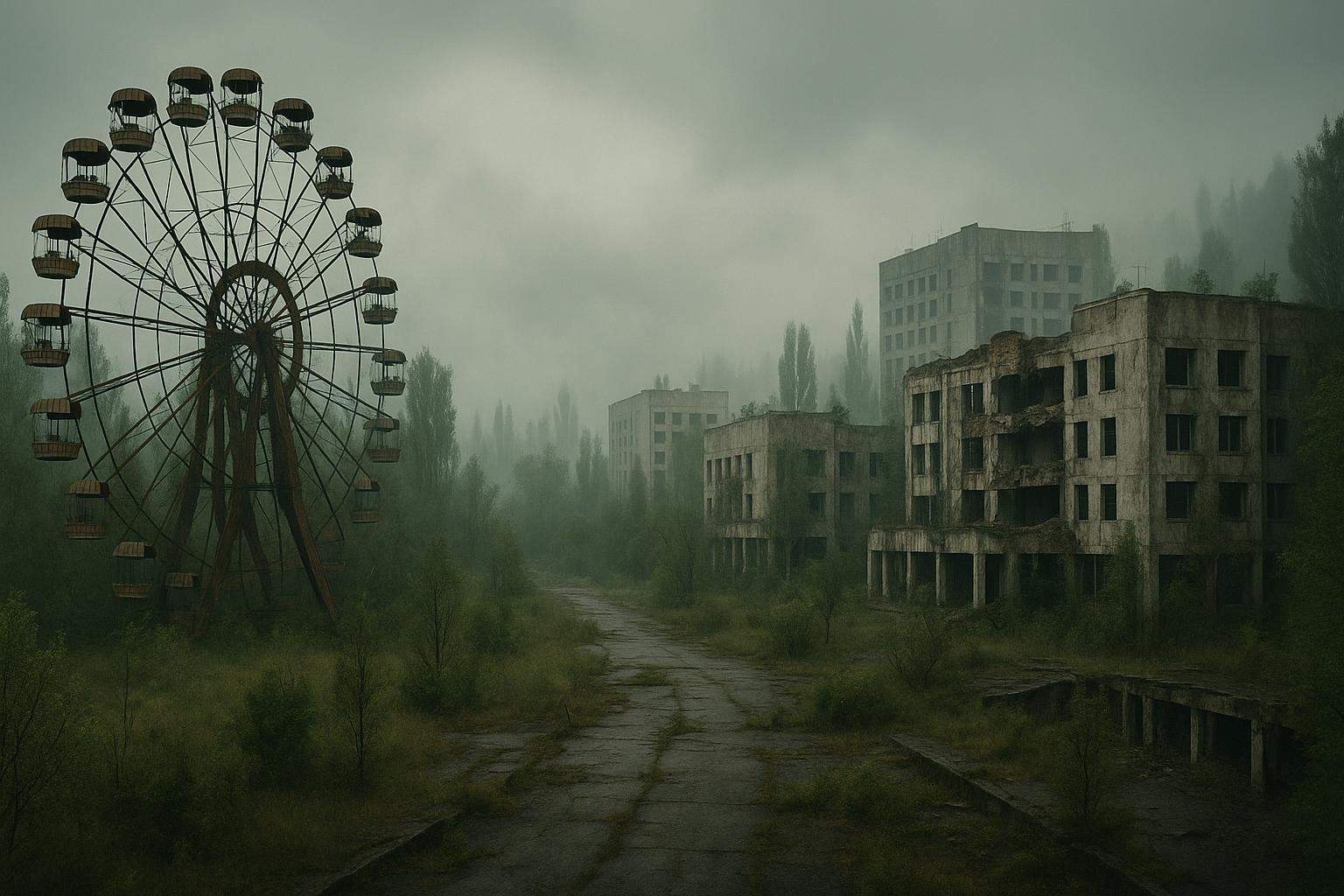
Perhaps the most famous modern ghost city, Pripyat was built as a model Soviet city to house workers of the Chernobyl Nuclear Power Plant. Its abandonment was sudden and complete, driven by a catastrophic event, yet the lingering danger and eerie preservation create a unique, mysterious atmosphere.
Location:
Located in northern Ukraine, near the border with Belarus.
Brief History:
Founded in 1970, Pripyat was a young, prosperous city with over 49,000 residents by 1986. It boasted modern amenities, including apartments, schools, hospitals, a cultural palace, a cinema, sports facilities, and an amusement park, intended to showcase Soviet progress.
The Abandonment:
On April 26, 1986, Unit 4 of the Chernobyl plant exploded. For nearly 36 hours, residents of Pripyat were not told the full truth about the disaster. On the afternoon of April 27th, authorities finally announced a temporary evacuation, telling residents to pack only essentials for three days. They never returned.
The Mystery/Circumstances:
While the reason for abandonment (the nuclear disaster) is known, the initial lack of information, the speed of the final evacuation (conducted in just a few hours using hundreds of buses), and the long-term effects of radiation created a veil of secrecy and lingering danger that makes Pripyat profoundly mysterious and unsettling. The fact that everything was left behind – personal belongings, toys, furniture – creates an eerie snapshot of interrupted lives. The true extent of the health consequences for those involved in the immediate aftermath and the long-term safety of the exclusion zone continue to be subjects of concern and investigation.
Current State:
Pripyat is the most famous part of the Chernobyl Exclusion Zone. It remains largely as it was left, though nature is slowly reclaiming the buildings. Radiation levels vary but are still dangerously high in many areas. It is now a destination for dark tourism, with guided tours available, offering a chilling look at a city frozen in time by disaster.
2. Centralia, Pennsylvania, USA – Burning Beneath
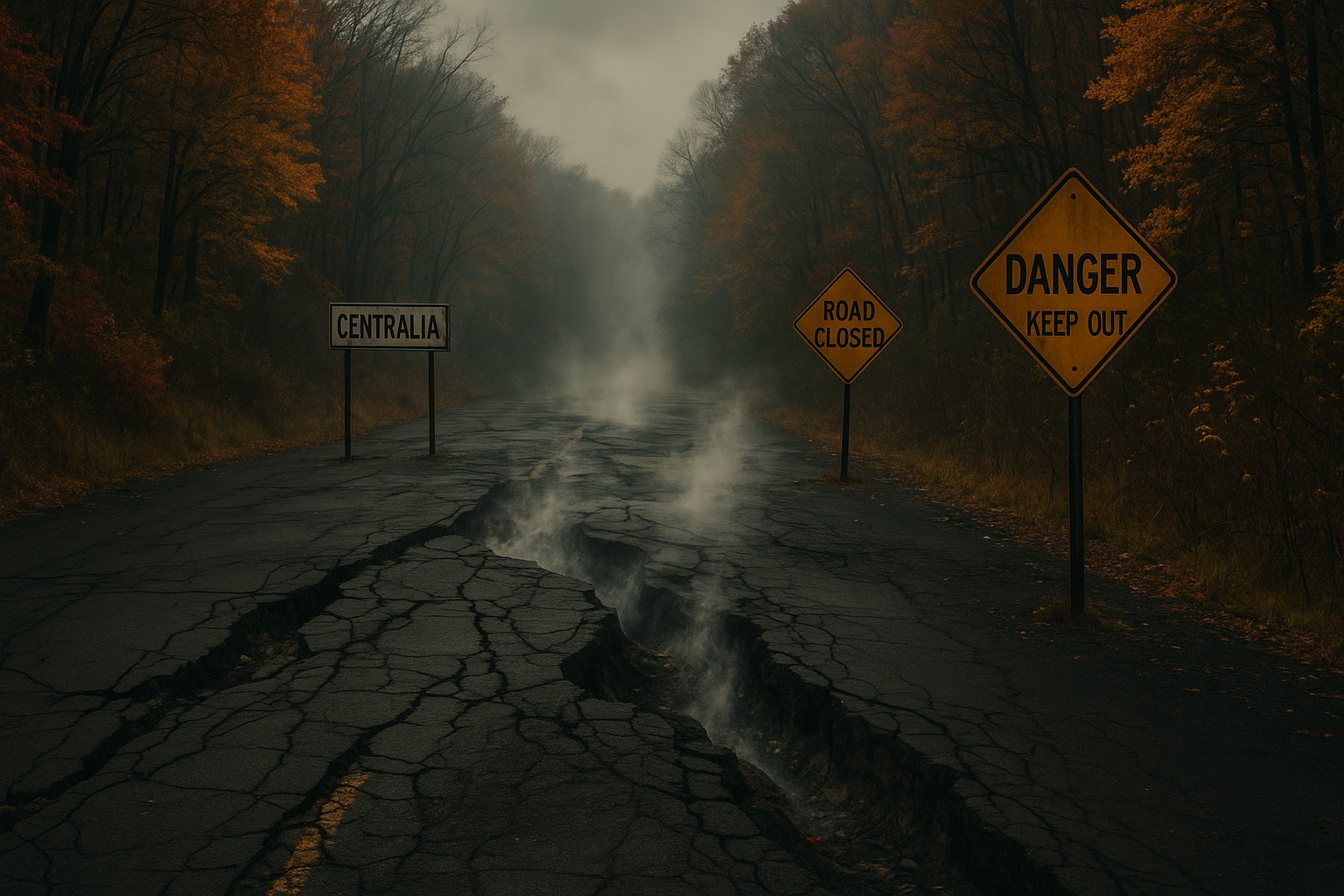
Centralia is not a town abandoned due to sudden disaster above ground, but by a slow, creeping catastrophe beneath it: an underground mine fire that has burned for decades.
Location:
Located in the Coal Region of Pennsylvania, USA.
Brief History:
Founded in the mid-19th century, Centralia was a bustling coal mining town. At its peak, it had several thousand residents, mines, churches, schools, and shops.
The Abandonment:
The town’s decline began in 1962 when a fire started in an abandoned coal mine beneath the town. It’s believed the fire was accidentally started when a trash dump in a mine pit was ignited and not properly extinguished, spreading into the coal veins. The fire proved impossible to put out. Over the following decades, it spread, releasing noxious fumes, causing the ground to heat up, and creating sinkholes. As the situation worsened, the government eventually condemned most of the town and relocated residents, a process that took many years. By the early 2000s, most buildings were demolished, and the population dwindled to a handful of residents who refused to leave.
The Mystery/Circumstances:
The mystery isn’t why the town was abandoned (the fire), but rather why the fire couldn’t be stopped despite numerous attempts and millions of dollars spent. The sheer scale and persistence of the underground blaze, which could burn for hundreds of years, is baffling. The visual effects – steam and smoke rising from cracks in the ground, surreal landscapes, and warning signs – give Centralia a bizarre, almost otherworldly feel.
Current State:
Centralia is now an unincorporated area with only a few remaining residents. Most streets are empty, leading to overgrown lots where houses once stood. The ground is unstable and emits smoke in places. A section of Route 61, rerouted due to cracks and subsidence, has become a bizarre, graffiti-covered attraction known as the “Graffiti Highway,” although public access is now restricted. The town’s zip code was revoked.
3. Craco, Italy – The Crumbling Hilltop Town

Perched precariously on a steep hill in southern Italy, Craco’s abandonment wasn’t due to a single event but a series of misfortunes culminating in mass departure.
Location:
Located in the region of Basilicata, southern Italy.
Brief History:
Dating back to the 8th century, Craco is a medieval town built on a high, rocky outcrop, typical of defensive settlements in the area. It was a farming town, surrounded by fertile land, though access was challenging due to the terrain.
The Abandonment:
Craco suffered from a combination of factors. The difficult terrain made infrastructure development challenging. More significantly, the hill it was built on is composed of soft, unstable clay. Repeated earthquakes and landslides over centuries took their toll. A major landslide in 1963 forced the evacuation of most of the town’s residents to a new settlement in the valley below, Craco Peschiera. Subsequent floods and earthquakes in the following decades further damaged the remaining structures and led to total abandonment.
The Mystery/Circumstances:
While the causes (landslides, earthquakes) are natural, the mystery lies in the town’s stubborn persistence on such an unstable site for over a thousand years, and the final, irreversible collapse of its fortunes in the mid-20th century. Its dramatic, desolate appearance, clinging to the hillside like a ghost, creates a powerful sense of mystery about the lives lived there and the final, inevitable defeat by nature. Why did they cling on for so long against the obvious geological threats?
Current State:
Craco is a dramatic, picturesque ruin. It has become a popular filming location for movies due to its stunning, melancholic beauty. Access is restricted and often requires a guide for safety due to the unstable ground and crumbling buildings, but it remains a captivating symbol of a town lost to the forces of nature.
4. Bodie, California, USA – A Gold Rush Freeze Frame
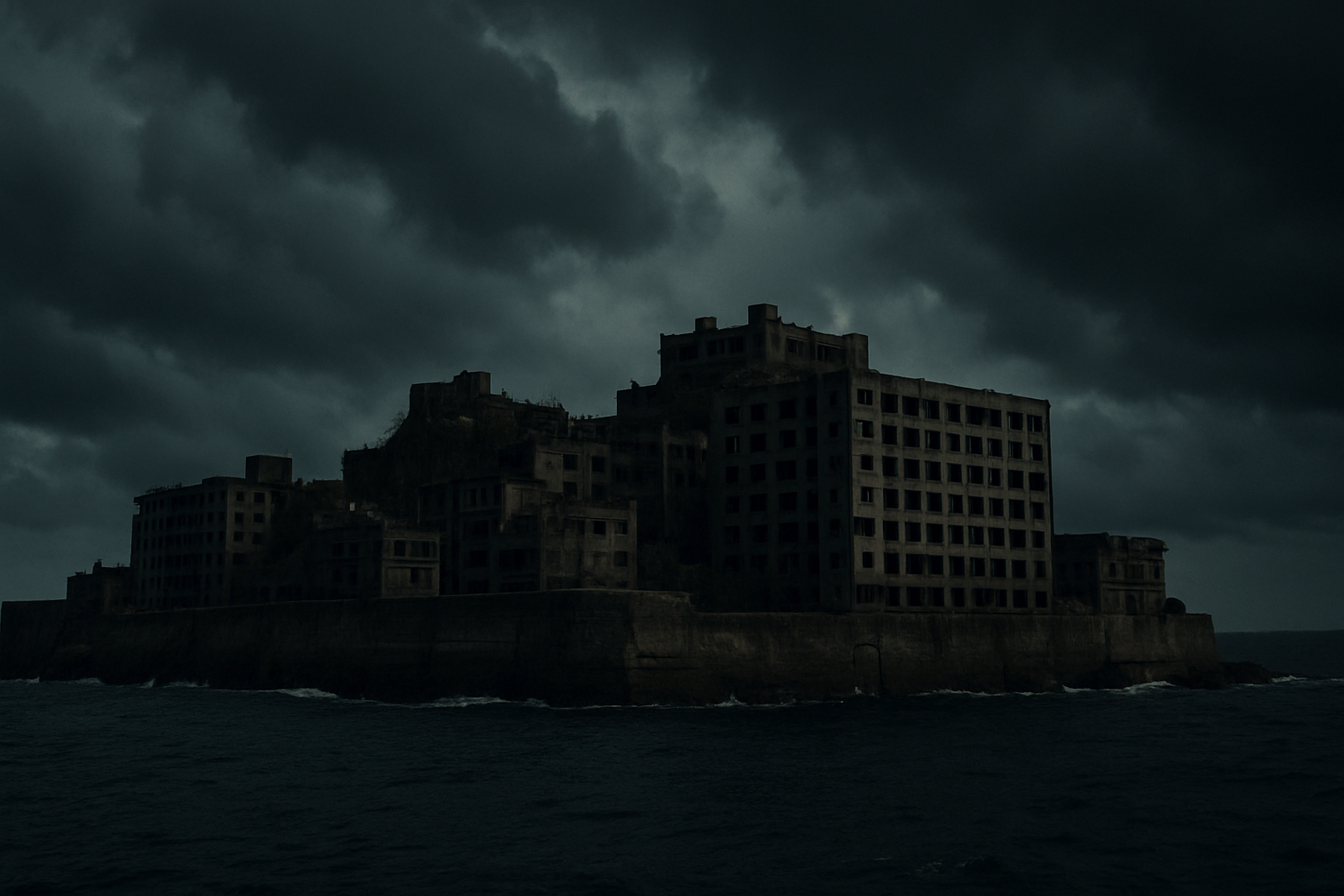
Bodie isn’t just an abandoned town; it’s a preserved state historic park, maintained in a state of “arrested decay,” giving it an incredibly eerie and authentic feel of a town suddenly frozen in time after its boom went bust.
Location:
Located in the Sierra Nevada mountains, California, USA.
Brief History:
Bodie was founded in 1876 after a gold strike. It quickly became a booming, albeit lawless and notoriously wild, mining town, reaching a population of up to 10,000 with saloons, brothels, stores, and mines operating round the clock. It was a place of sudden wealth and even more sudden death.
The Abandonment:
The gold eventually ran out, or became too difficult and expensive to extract profitably. By the early 20th century, the population began a rapid decline as miners moved to other strikes. A series of fires also destroyed parts of the town. While not abandoned overnight, the departure was quick once the boom ended. By the 1940s, only a handful of caretakers remained. In the 1960s, California State Parks took over, choosing to preserve it in its decaying state rather than restore it.
The Mystery/Circumstances:
The mystery of Bodie lies less in the reason for abandonment (the gold ran out) and more in how it was left and subsequently preserved. Many buildings still contain goods on the shelves, furniture, and personal items, giving the chilling impression that residents simply walked away from their lives. The dusty, silent streets and creaking buildings feel haunted, a powerful echo of a time of frenetic energy and sudden silence. The decision to preserve it in decay, rather than as a living history museum, enhances this sense of mystery and abandonment.
Current State:
Bodie State Historic Park is one of the best-preserved ghost towns in the United States. Visitors can walk the streets and peer into buildings filled with artifacts from the past. It is kept deliberately rustic and decaying, offering an unparalleled look at a Wild West town frozen in time.
5. Kolmanskop, Namibia – Swallowed by the Desert
Kolmanskop is a hauntingly beautiful ghost town slowly being reclaimed by the shifting sands of the Namib Desert, a stark reminder of a boom that went bust and the relentless power of nature.
Location:
Located in the Namib Desert, a few kilometers inland from the port town of Lüderitz, Namibia.
Brief History:
Founded in 1908 during the diamond rush in German South-West Africa, Kolmanskop was a wealthy town with impressive European-style architecture, a hospital, ballroom, power station, school, and even a casino. Everything needed for a comfortable European life was imported across the desert.
The Abandonment:
The town’s fate was tied entirely to diamonds. After World War I, diamond prices crashed, and richer diamond fields were discovered further south. Residents began to leave, and by 1930 the town was in steep decline. Operations eventually ceased entirely, and Kolmanskop was completely abandoned by 1956.
The Mystery/Circumstances:
The abandonment wasn’t sudden or truly mysterious in terms of why (economic collapse). However, the mystery lies in the town’s rapid and dramatic transformation as the desert immediately began its silent invasion. Homes are now half-filled with sand, dunes creep through doorways and windows, and the once-lavish buildings are slowly being swallowed. The visual effect of a European town being consumed by one of the world’s oldest deserts is profoundly eerie and mysterious, prompting contemplation on the ephemeral nature of wealth and human endeavor in the face of overwhelming natural forces.
Current State:
Kolmanskop is now a popular tourist attraction and a photographer’s dream. Managed by a diamond company, guided tours are available, allowing visitors to explore houses filled with sand and witness the desert’s slow but relentless takeover.
6. Hashima Island (Gunkanjima), Japan – The Battleship Island’s Silence
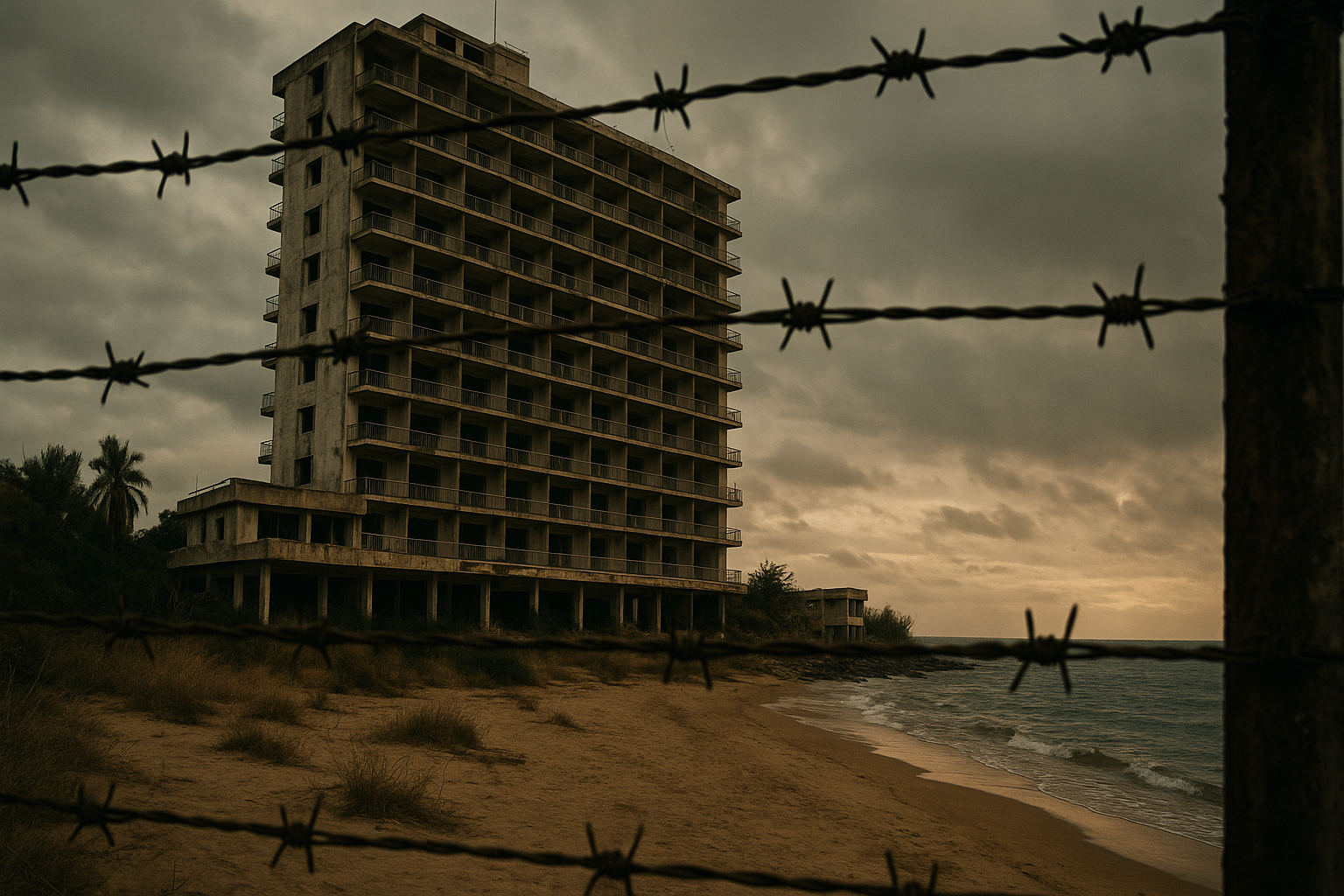
Hashima Island, commonly known as Gunkanjima (“Battleship Island”) due to its appearance, is an iconic, haunting symbol of rapid industrialization and equally rapid abandonment.
Location:
Located about 15 kilometers (9 miles) from Nagasaki city, Japan.
Brief History:
Hashima Island was purchased by Mitsubishi in 1890 for undersea coal mining. It became an incredibly dense residential and industrial island, housing miners and their families. Concrete high-rise buildings were constructed to accommodate the growing population, which peaked at over 5,000 residents in 1959, making it one of the most densely populated places on Earth at the time.
The Abandonment:
When petroleum replaced coal as Japan’s primary energy source in the 1960s, the demand for coal plummeted. The mine on Hashima was no longer profitable. In January 1974, Mitsubishi officially announced the closure of the mine. The residents left the island almost immediately in the following months.
The Mystery/Circumstances:
The reason for abandonment (economic shift) is clear. However, the mystery and eerie atmosphere stem from the incredible speed of the departure and the preservation of the island’s decaying concrete structures. It looks like an entire city was vacated in a matter of weeks. Personal belongings, appliances, and even children’s toys were left behind in apartments, creating a chilling sense of interrupted lives. The island’s isolation and the brutalist architecture overtaken by nature enhance its mysterious, post-apocalyptic feel. Its past, including the use of forced labor during WWII (which is a somber historical fact, not a “mystery” of abandonment, but contributes to the island’s complex and sometimes dark aura), adds layers to its history.
Current State:
Hashima Island was officially reopened for public visits (via guided boat tours) in 2009, with a portion of the island accessible via a boardwalk to protect visitors from collapsing structures. It is a UNESCO World Heritage site (as part of the Sites of Japan’s Meiji Industrial Revolution), recognized for its historical significance, but its appearance is pure ghost town, attracting global fascination.
7. Pyramiden, Svalbard – The Soviet Arctic Outpost
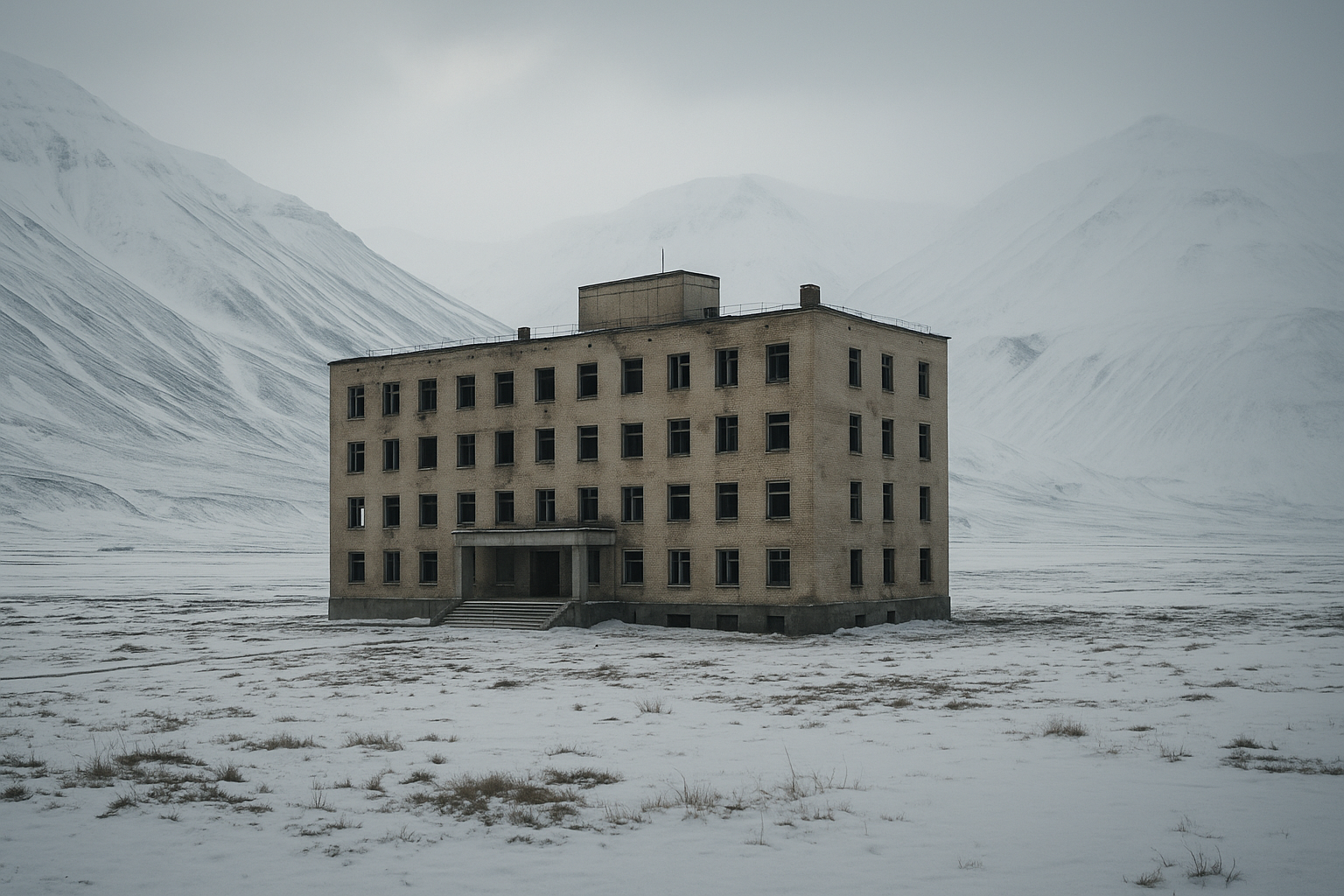
Pyramiden is a former Soviet mining settlement on the remote Arctic archipelago of Svalbard. Its abandonment was remarkably swift, leaving behind a time capsule of Soviet life in the high north.
Location:
Located on Spitsbergen island in the Svalbard archipelago, Norway (though historically a Soviet/Russian settlement).
Brief History:
Founded by Sweden in 1910, Pyramiden was sold to the Soviet Union in 1927. It was developed into a showcase community for Soviet ideology in the Arctic, with apartment blocks, a hospital, cultural center, school, library, sports facilities, and the world’s northernmost statue of Lenin. Life was relatively comfortable by Soviet standards, designed to attract and retain miners.
The Abandonment:
In 1998, the Russian state-owned company Arktikugol decided to close the mine permanently due to economic reasons (low coal prices and high operating costs). The decision was sudden. Over the next few months, the residents, numbering over 1,000, left Pyramiden. By October 1998, the settlement was completely abandoned.
The Mystery/Circumstances:
While the economic reason for the mine closure is stated, the sheer speed and totality of the abandonment, leaving behind furniture, books, pianos, and even laboratory equipment, give Pyramiden a particularly eerie feel. It’s a perfectly preserved snapshot of a Soviet Arctic community at the moment the lights went out. The isolation, the harsh environment, and the silent, empty buildings under the Arctic sky contribute to its mysterious atmosphere, prompting questions about daily life there and the sudden end to their isolated existence.
Current State:
Pyramiden is now a ghost town accessible mainly by boat in the summer and snowmobile in the winter. A hotel has been reopened, and guides offer tours through the decaying settlement. The cold climate helps preserve the buildings, making it a remarkable, though somewhat melancholy, place to visit.
8. Kayaköy, Turkey – The Ghost Village of the Aegean
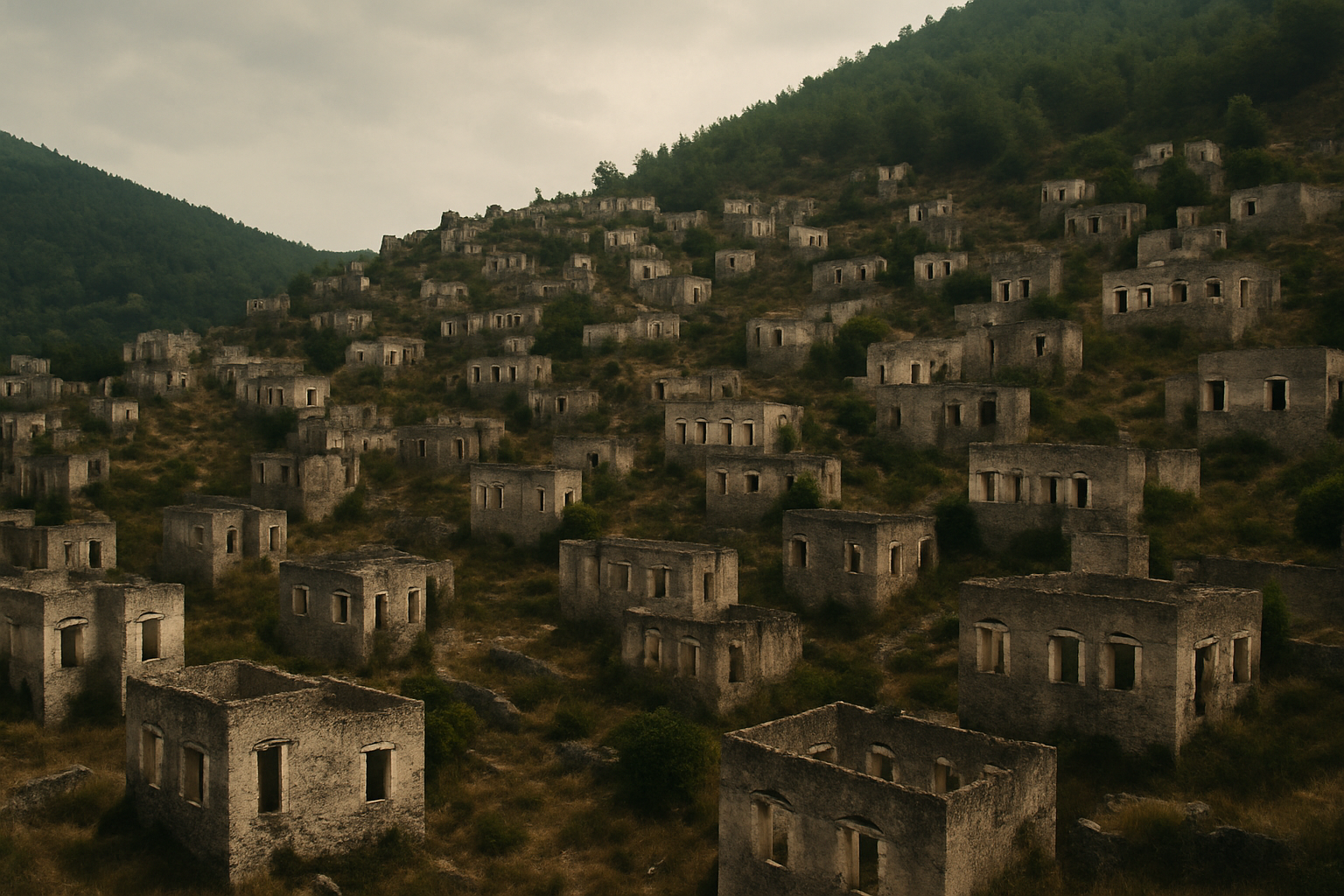
Kayaköy is a large, hillside ghost village in southwestern Turkey, abandoned due to a complex and tragic historical event rather than natural disaster or economic collapse.
Location:
Located near the tourist town of Fethiye in southwestern Turkey.
Brief History:
For centuries, Kayaköy (historically known by its Greek name, Levissi) was a thriving town inhabited primarily by Anatolian Greeks, alongside a smaller Turkish population. It had churches, schools, and shops and was a significant regional center.
The Abandonment:
Following the Greco-Turkish War (1919-1922) and the collapse of the Ottoman Empire, a population exchange agreement was signed between Greece and Turkey in 1923. This compulsory exchange was based on religious identity, not ethnicity. The Greek Orthodox residents of Kayaköy were forced to leave their homes and move to Greece, while Muslims living in Greece were sent to Turkey.
The Mystery/Circumstances:
The reason for the abandonment is a clear historical event – the forced population exchange. However, the mystery lies in the profound sense of loss and the enduring, silent presence of empty stone houses built side-by-side, overlooking the valley. The scale of the forced departure, leaving behind a near-complete village, creates a haunting atmosphere. Turkish Muslims sent from Greece were later settled in the area but found the stone houses unsuitable for their lifestyle and built new homes lower down the valley, leaving the old town deserted. The “mystery” is less about the cause and more about the poignant human story of a vibrant community’s sudden, forced displacement and the eerie silence of the homes they left behind.
Current State:
Kayaköy is now a protected historical site and a major tourist attraction. Hundreds of stone houses, two large churches, and other buildings stand empty on the hillside. It serves as a powerful and melancholic memorial to the human cost of political decisions.
9. Famagusta (Varosha),Cyprus – The Fenced-Off Resort
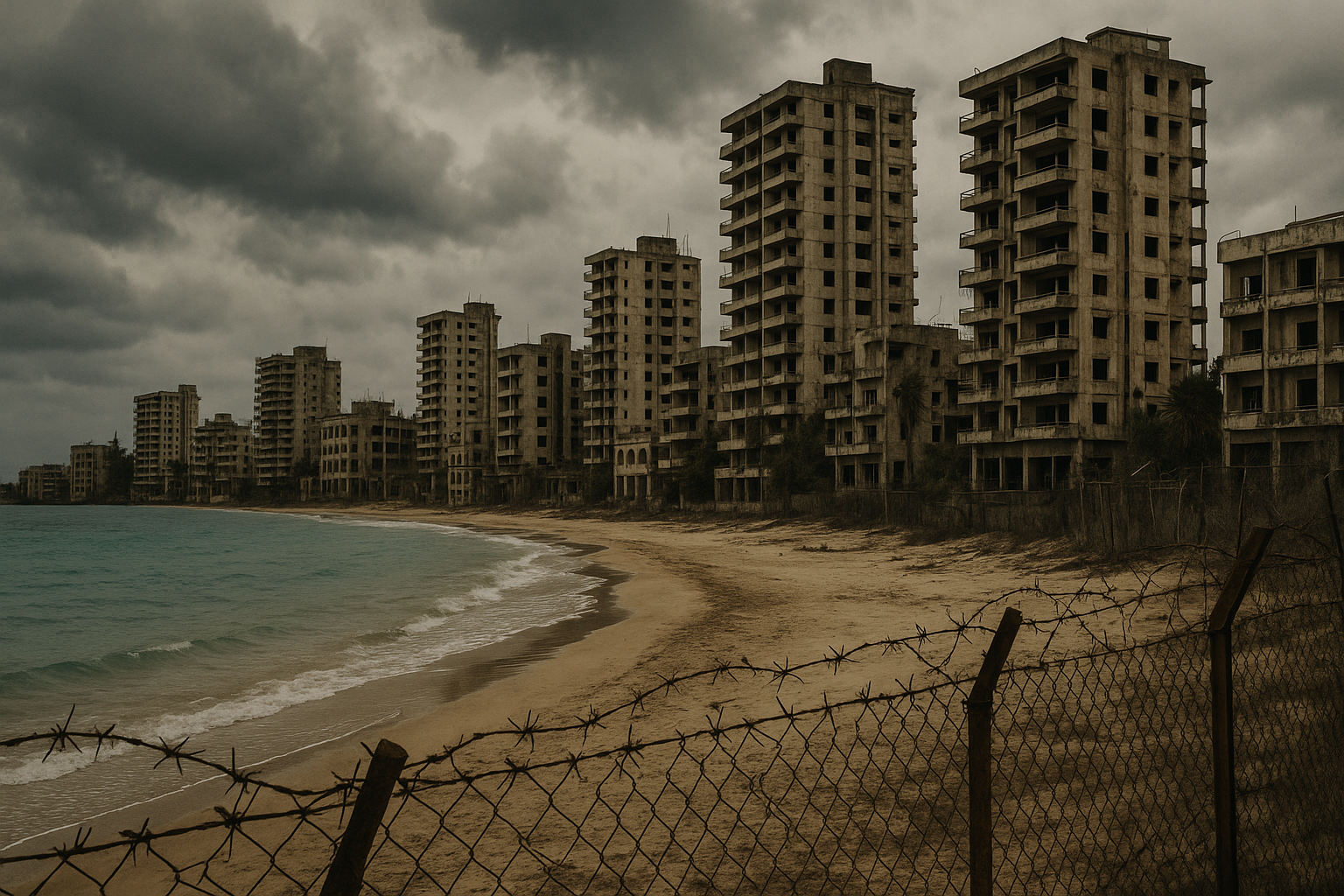
Varosha, a southern quarter of the city of Famagusta in Northern Cyprus, was once a glamorous tourist resort. It became a ghost town overnight due to military conflict and remains fenced off and inaccessible, frozen in a moment of time.
Location:
Located on the eastern coast of Cyprus, within the city of Famagusta.
Brief History:
In the late 1960s and early 1970s, Varosha developed into a major tourist destination, attracting celebrities and wealthy visitors. It boasted modern high-rise hotels, apartment buildings, restaurants, and shops along beautiful beaches.
The Abandonment:
In July and August 1974, Turkey invaded Cyprus following a Greek Cypriot coup. As Turkish forces advanced, the Greek Cypriot residents of Varosha fled south, expecting to return once the situation calmed. However, the area came under Turkish military control and was immediately fenced off.
The Mystery/Circumstances:
Again, the reason for abandonment was a military action. The mystery lies in the town’s unique state of preservation behind barbed wire and military patrols. For decades, it has stood empty, the former hotels and apartments slowly decaying, swallowed by vegetation, their contents often still visible from a distance. The suddenness of the departure and the subsequent inability for residents to return, leaving a modern resort frozen since 1974, creates a powerful sense of suspended time and unresolved conflict. Why it has remained completely sealed off for so long, despite various peace initiatives, adds to the international mystery surrounding its fate.
Current State:
Varosha remains a restricted military zone, surrounded by fences and signs warning against entry. The buildings are crumbling, and nature is encroaching. A small section was controversially reopened to the public for limited visits in recent years, allowing a glimpse into this hauntingly preserved ghost town.
10. Agdam, Azerbaijan – The Caucasian Hiroshima
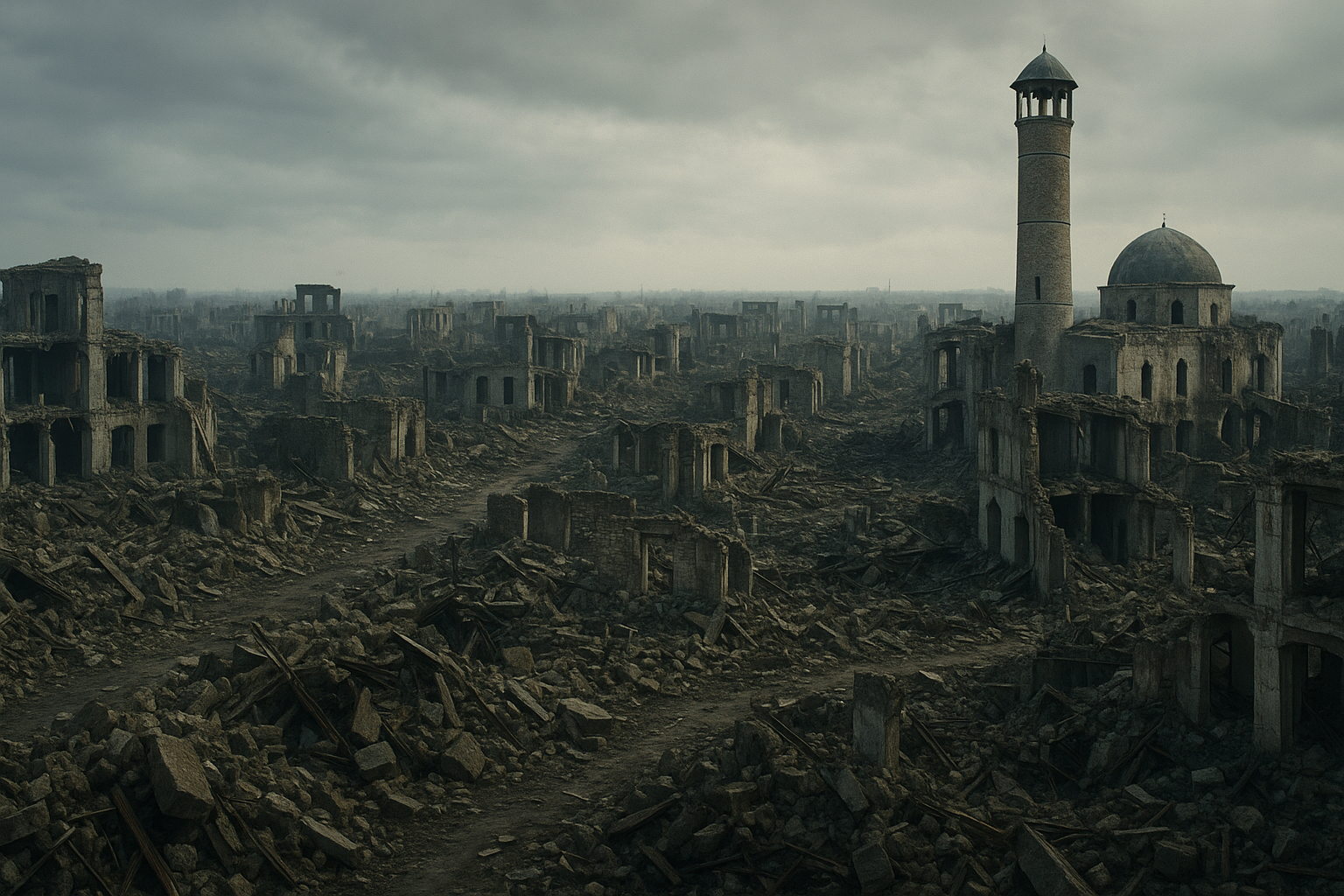
Agdam was once a city of nearly 40,000 people, known for its industry and cultural life. It was reduced to ruins and completely emptied during wartime and became a chilling symbol of destruction, often called a “ghost city” or “Caucasian Hiroshima.”
Location:
Located in the Karabakh region of Azerbaijan.
Brief History:
Agdam was a prosperous city during the Soviet era, known for its agriculture, industries (like wine and cheese production), and its cultural significance, including a famous bread museum and a mosque.
The Abandonment:
During the First Nagorno-Karabakh War (1988-1994), Agdam was heavily damaged and captured by Armenian forces in 1993. Following its capture, the Azerbaijani population fled. The occupying forces subsequently destroyed most of the city’s buildings to prevent the Azerbaijani army from retaking it and to use building materials.
The Mystery/Circumstances:
The cause of abandonment was war and deliberate destruction. The “mystery” and haunting aspect come from the town’s almost complete erasure, leaving behind a vast area of rubble with only a few structures, most notably the partially ruined mosque, still standing as skeletal remains. It’s a ghost city created not by nature or simple economic decline, but by intentional human violence and strategic devastation. The sheer scale of the destruction and the emptiness of a once-thriving city are profoundly unsettling.
Current State:
After the 2020 Nagorno-Karabakh War, Azerbaijan regained control of the Agdam district. The city remains largely in ruins, a vast and desolate area undergoing slow reconstruction efforts. It stands as a stark and tragic ghost city born purely from conflict.
Conclusion
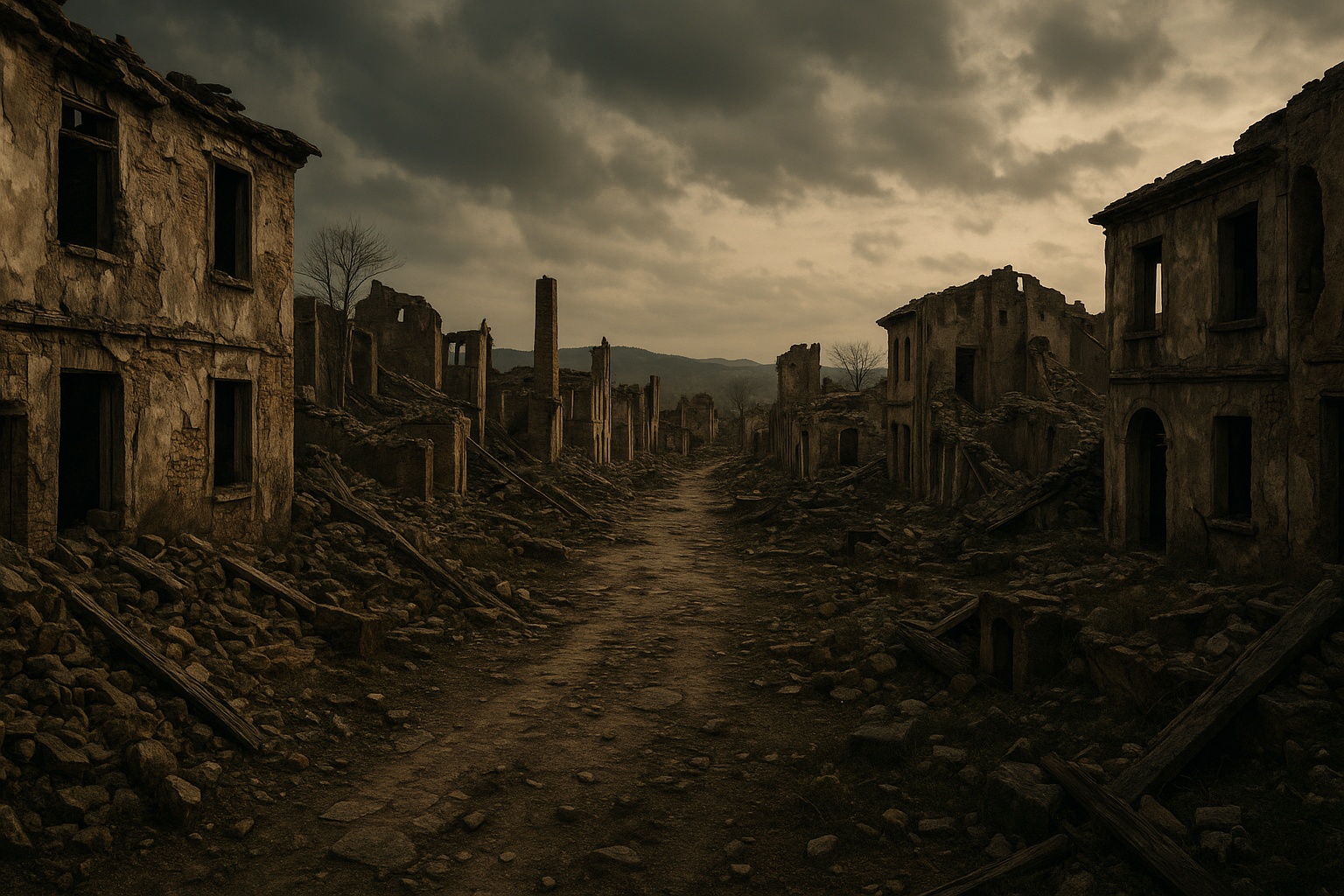
These 10 towns, abandoned under circumstances that range from sudden nuclear disaster and persistent underground fires to economic collapse, geological instability, forced migration, and wartime destruction, serve as poignant reminders of the unpredictable forces that can render human settlements obsolete overnight or over decades.
Each empty street, each decaying building holds silent stories of the lives that were lived there and the reasons – clear or still debated – why they were left behind. They invite us to contemplate the transient nature of civilization and the enduring power of both nature and human events to shape our world. These ghost towns, wrapped in their unique veils of mystery, continue to stand as fascinating, often haunting, monuments to the past.
